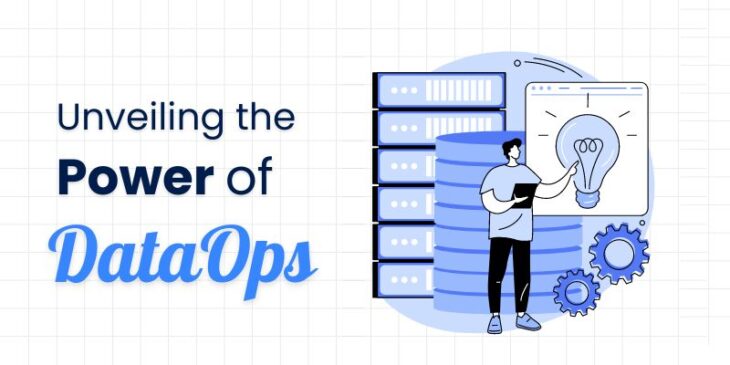
In today’s dynamic space of data-driven decision-making and technology, effective handling and management of data play a crucial role. The traditional methods of data engineering and management are no longer efficient. Big data, real-time analytics and the need for fast, actionable insights outpace any capability to handle them. To solve this problem comes DataOps. DataOps is derived from the principles of DevOps, Agile and Lean methodologies to optimize the whole data lifecycle. Here, in this blog, we’ll talk about DataOps, key principles of DataOps and techniques for implementing DataOps. Let’s begin!
What is DataOps?
DataOps (Data Operations) is a process that provides a toolset, procedures and best practices for the improvement of data management, enabling organizations to work with reliable data sets more efficiently. Basically, DataOps is derived from the principle of DevOps where, collaboration, automation and continuous enhancement are considered the major influencing factors.
The primary purpose of this solution is to improve effectiveness and efficiency in the data pipeline workflow and to bring more productivity between business users and data scientists.
Key Principles of DataOps
DataOps, as it stands for Data Operations, is a team-based data management philosophy prioritizing communication, integration and automation within an organisation. Listed below is the set of principles for implementing DataOps:
- Agile methodology: After the adoption of DataOps practices, the Agile methodology enables teams to respond to new requirements quickly and efficiently. Instead of handling work in one piece, the team will divide the work into smaller, more achievable tasks, creating a possibility to deliver value sooner and enhance the process over time.
- Automation: Efficiency lies at the core of DataOps via automation. Teams can benefit from fast-offering solutions through automated processes. Already, some of the processes which can’t be automated have been profiled. These include data integration, assessment as well as deployments. Getting rid of human interaction minimizes mistakes, accelerates the flow of informational data and boosts efficiency.
- Continuous Integration/Deployment: DataOps now to some extent executes CI/CD activities used in the software development world. It covers the essentials such as merging new code, automating tests and offering new capabilities or features. In DataOps, this means ensuring that high-quality data is being exchanged seamlessly and regularly.
Data Implementation Techniques
DataOps, short for Data Operations, is an approach that integrates data engineering, collaboration and processes to optimize and reduce data analysis cycle times. There are data scientists, data engineers and other people who are involved in the data lifecycle. Implementing DataOps helps establish smooth collaboration between them by emphasizing communication, integration and automation of processes. Here are some tips for implementing DataOps.
Version Control for Data
- Git for Data: Implement version control principles to control data sources with the help of tools like Git. Doing this ensures tracking changes to data entities and models. This leads to collaboration and iteration.
Automated Testing
- Data Quality Checks: Apply automated testing techniques to make sure that only reliable and unaltered data is used in the entire data pipeline. Another important aspect of implementing automation of checks is that it attempts to prevent early failures and catches them before the problem arises in a data-driven business environment.
Continuous Integration and Continuous Deployment
- Automated Deployment Pipelines: Implement CI/CD practices, where testing and deployment of data pipelines are automated, thus making the deployment of data pipelines more efficient, repeatable and error-free.
Infrastructure as Code (IaC)
- Automated Provisioning: Leverage tools such as Terraform or Ansible to have all the infrastructure components provisioned, ensuring they run similarly throughout different environments.
Monitoring and Logging
- Centralized Logging: Implement centralized logging to review the accuracy of data to ensure the stable performance of the data pipeline. This also helps in troubleshooting quicker. Tools such as ELK can be helpful here, which include Elasticsearch, Logstash and Kibana.
- Alert Systems: Establish alerts to inform teams whenever predefined thresholds are exceeded or any anomalies are detected in the data pipeline. Integration of Artificial Intelligence methods helps to identify issues in advance and intelligently in the data-driven business environment.
Containerization and Orchestration
- Containerization: Utilize containerization tools like Docker for packaging and delivering Data applications consistently across different environments.
- Orchestration: Leverage orchestration tools like Kubernetes or Apache Airflow to handle and schedule complex data workflows.
Security and Compliance
- Data Governance: Establish data governance policies to confirm compliance of these policies with set regulations and standards.
- Encryption and Access Controls: Implement the encryption protocols for data that is highly confidential and enforce the access controls to restrict user access.
Implement a cultural shift that values automation and collaboration while being driven by authentic business value through data. These techniques are often adapted and built upon in DataOps DataOps for cloud-native environments, making it an evolving best practice.
Final Wrap-Up
Given organizations’ increasing need to navigate the vast array of data pooling, DataOps has transitioned from being a want to a need. The new approach to collaborative, responsive and agile principles of DataOps for cloud-native environments is revolutionizing data management standards, ensuring that the data stays valuable and becomes integral to strategic business priorities.
DataOps is a vital component in the data governance space which covers everything from enabling cross-functional teams to increasing data quality, speed and scalability. A properly built DataOps strategy is essential. Not only does it lighten the load, but it also allows businesses to make critical decisions quickly and confidently.



